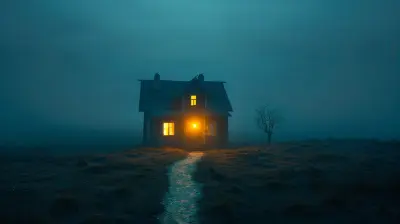The Essential Role of Post-Processing in Real Estate Photography
7 November 2025
Introduction
Ever scrolled through a real estate listing and been instantly drawn to a property's stunning photos? Chances are, those images aren't straight out of a camera. The secret? Post-processing.
In today's competitive market, quality real estate photography can mean the difference between a house that sells fast and one that lingers for months. But taking a picture is just half the battle—post-processing is where the magic happens. From adjusting lighting to correcting colors, post-processing ensures that every photo captures the property in its best possible light.
So, why exactly is post-processing so crucial in real estate photography? Let’s dive in.

Why Post-Processing Matters in Real Estate Photography
1. First Impressions Sell Homes
Homebuyers shop with their eyes first. Before they ever step foot in a house, they decide whether it’s worth their time based on listing photos. If your images look dark, dull, or unappealing, potential buyers will scroll right past—even if the home is perfect for them.Post-processing transforms good photos into great ones, making a listing stand out in a crowded market. It enhances brightness, sharpens details, and ensures colors are accurate, making the property look as inviting as possible.
2. Correcting Lighting Issues
Even the most experienced photographers can’t always control lighting conditions. Natural light shifts throughout the day, and indoor lighting can create unwanted shadows or color casts.With post-processing, you can:
- Brighten underexposed images
- Remove harsh shadows
- Balance indoor and outdoor lighting for a natural look
A well-lit photo feels warm and welcoming, precisely what buyers want to see.
3. Enhancing Color Accuracy
Ever noticed how some listing photos have oddly tinted walls or floors that look completely different from reality? That’s a color balance issue.Post-processing corrects these distortions, ensuring that:
- Whites look white, not yellow or blue
- Wood floors don’t appear too red or orange
- Walls maintain their true, natural tones
Accurate colors create a sense of realism, helping buyers trust that what they see online matches what they'll see in person.
4. Sharpening Details and Increasing Clarity
Blurred edges and soft focus can make a listing feel underwhelming. Crisp, detailed images—where every texture and finish is visible—are far more engaging.Post-processing enhances sharpness and clarity, making elements like countertops, flooring, and fixtures pop. This added level of detail helps buyers envision themselves in the space, making them more likely to schedule a showing.
5. Sky Replacement for Exterior Shots
A bright, sunny sky can completely change the feel of an exterior shot. But what if your photoshoot day was cloudy or gray?Post-processing allows for sky replacement, transforming a dull sky into a stunning, blue one. This simple tweak makes outdoor shots more vibrant and appealing, adding an extra touch of professionalism to the listing.
6. Removing Distractions
Sometimes, a great shot is ruined by minor distractions—a garbage can in the frame, clutter on a countertop, or an awkward reflection in a mirror. Post-processing lets you clean up these imperfections, ensuring nothing distracts from the property's beauty.A clean, polished image keeps the focus on the home itself, rather than on minor flaws that could turn buyers away.
7. HDR Processing for Balanced Exposure
High Dynamic Range (HDR) processing is a game-changer in real estate photography. Sometimes, a room's interior looks perfect, but the view outside the window is completely overexposed. Other times, bright outdoor light causes the interior to appear too dark.HDR processing blends multiple exposures into a single image, ensuring that both indoor and outdoor elements are perfectly balanced. This technique creates a more realistic representation of the space, making rooms feel naturally bright and inviting.

Essential Post-Processing Techniques in Real Estate Photography
1. Brightness & Contrast Adjustments
Adjusting brightness ensures that every detail in a photo is clearly visible, while contrast enhances the depth, making images feel more dynamic rather than flat.2. White Balance Correction
This fixes unnatural color casts caused by different lighting conditions, ensuring that colors remain consistent and realistic.3. Perspective & Lens Correction
Wide-angle lenses are commonly used in real estate photography, but they can sometimes create distorted lines. Perspective correction straightens edges, making sure walls and door frames look accurate.4. Noise Reduction
Low-light shots often introduce grainy textures, or "noise." Reducing noise makes images smoother and more polished.5. Object Removal
Distracting elements like cables, reflections, or minor imperfections can be erased to keep photos looking clean and professional.
The Impact of High-Quality Post-Processing
1. Higher Engagement on Listings
Buyers spend more time on listings that feature bright, sharp, and visually appealing photos. More engagement means more inquiries, leading to faster sales.2. Increased Perceived Value
Professionally edited photos make a property look high-end, even if it's modestly priced. This perceived value can lead to stronger offers and quicker sales.3. Competitive Edge
In a sea of listings, top-tier photos make a home stand out. If competing properties have subpar images, a professionally edited listing will automatically attract more attention.
Is Post-Processing Always Necessary?
Some may wonder—can’t good photography stand on its own without editing? While it's possible to get great shots straight from the camera, even professional photographers use post-processing to refine and enhance their images.Think of it this way: A chef doesn’t just toss raw ingredients on a plate and call it a meal. They season, arrange, and present the dish beautifully. Post-processing does the same for real estate photos—it takes solid raw material and refines it into something truly appealing.
Final Thoughts
In the world of real estate photography, post-processing isn’t just a luxury—it’s a necessity. It enhances lighting, perfects colors, removes distractions, and ensures every property is showcased in its best light.Whether you're a real estate agent, photographer, or homeowner looking to sell, investing in high-quality editing will help listings shine, attract more buyers, and ultimately lead to faster, more profitable sales.
Want your listings to stand out? Make post-processing a priority—it’s the secret ingredient to real estate photography success.
all images in this post were generated using AI tools
Category:
Real Estate PhotographyAuthor:

Vincent Clayton
Discussion
rate this article
1 comments
Adria Hughes
Post-processing transforms good photos into stunning visuals! Embracing this essential step enhances your listings and captivates potential buyers, making your properties truly shine. Keep capturing!
November 7, 2025 at 5:10 AM

Vincent Clayton
Thank you! I completely agree—post-processing is vital for highlighting the true beauty of properties and attracting buyers.


